Beyond the Page
Published May 2024
By Steffie Corcoran | 20 min read
The word community shows up a lot in conversations about public libraries. Oklahoma Department of Libraries director Natalie Currie, whose infectious energy disproves any old notion of librarians as stern, cardigan-wearing shushers, says, “The statute reads that libraries are essential to helping Oklahomans achieve their individual life goals. Public libraries in our state are deeply embedded in each of our local communities. They are staffed by community members, fellow Oklahomans serving Oklahomans. They intimately know the needs of their communities.”
The statute she’s referring to, from Title 65, 1-102, reads in part, “It shall be the policy of the State of Oklahoma to promote, support, and implement the development and maintenance of adequate public and special library facilities and services throughout the state. . . . library services are deemed to be necessary to the cultural, educational, and economic development of the State of Oklahoma and to the health, safety, and welfare of its people. . . .”
In other words, public libraries are enshrined in the Oklahoma Constitution.
For many, libraries are sacred spaces with infinite, mostly free, access to media and other resources that link us to our best selves and lives well lived. Many of the state’s more than two hundred public libraries merit a visit, but these five will jump-start any bibliophilic road trip.
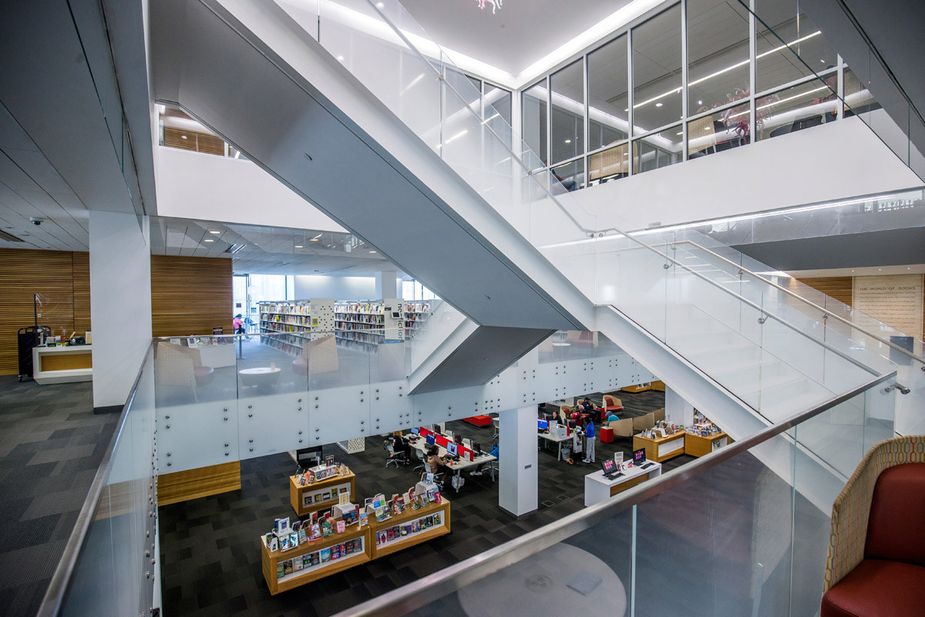
At more than 145,000 thousand square feet, Tulsa’s Central Library is a sprawling learning center in the city’s downtown. Photo courtesy Shane Bevel
El Reno may be best known for Route 66 and fried-onion burgers, but its historic downtown also claims one of the oldest public libraries in the state, the El Reno Carnegie Library. Opened in 1905 in Oklahoma Territory after businessman and philanthropist Andrew Carnegie granted El Reno $12,500 for construction, the Classical Revival-style building was the fourth of twenty-four Carnegie-funded municipal libraries built in the state between 1901 and 1916.
The two-story exterior with a portico, four Ionic columns, and pedimented entry with transom always has been stately—it was added to the National Register of Historic Places in 1980. But when library director Bridget Scheffler dropped in to get her library card after moving to El Reno in 2018, she says, “All the windows were covered in drapes, there were bookshelves in front of the windows, everything was very dark, and the plaster in the walls was all cracked.”
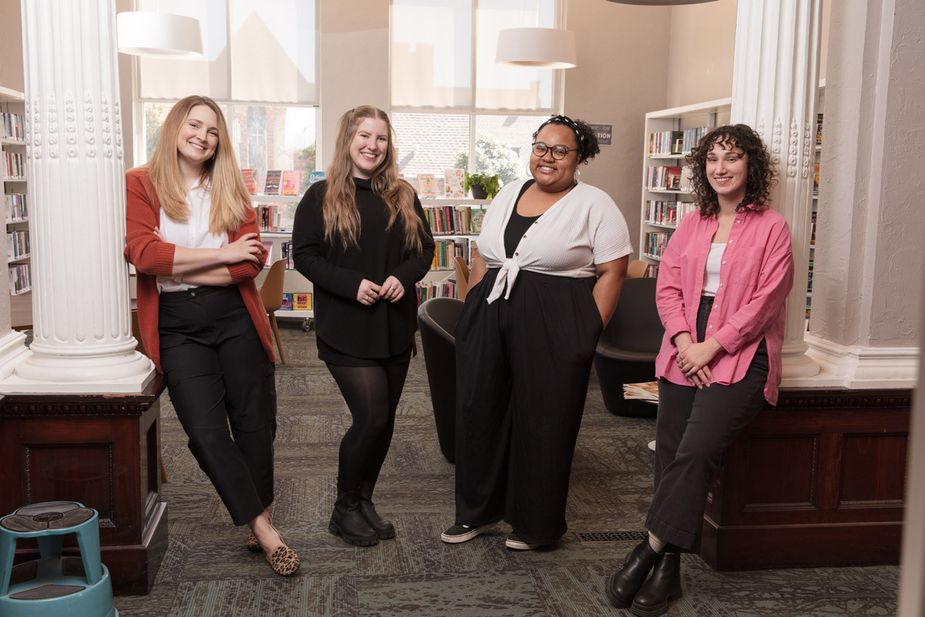
From left: Library director Bridget Scheffler, technical processor Leslie Hindman, teen/adult librarian Shae Frierson, and children’s librarian Maddie Razook in the El Reno Carnegie Library. Photo courtesy Brent Fuchs
That is emphatically no longer the case. The 8,266-square-foot facility still is a stunner with gleaming original marble lobby and stairs, embossed Florentine metal ceilings, and elaborately decorative terra cotta flourishes. But a 2019 renovation has transformed it into a bright, lively space with fresh paint, energy-efficient windows that bring the natural light in, and a new vibe embodied by Scheffler and her energetic staff.
“People are kind of surprised when we’re all younger, it’s more vibrant in here, and we’re not as quiet,” she says.
“Especially upstairs!” calls out children’s librarian Maddie Razook, whose renovated second-floor domain is a colorful kids’ area with modular furniture and an open, exploration-worthy space plan.
The building and its staff occupy two worlds. One is grounded in history, while the other keeps an eye on current community needs and interests. Innovative programming includes Baby Storytime, Teen Game Time, a weekly Zumba class, and a partnership with El Reno Public Schools that brings a pre-K class to the library every week during the school year. Scheffler notes that for the small staff, it’s really all about what the community needs.
“Almost anybody who has had interactions with libraries in their communities, including this one, knows that the library is a place where they can go to have questions answered or at least get positive feedback on whatever it is that they’re trying to accomplish,” she says. “We want people to have good experiences here.”

Play and storytime gatherings are among the popular programs at the Central Library. Photo courtesy Shane Bevel
Precisely 331,037 physical items. More than 308,000 annual visitors. 216,735 items circulated in 2023. 145,391 square feet. While processing the sheer scale of what the Tulsa’s Central Library has to offer, consider that on the second floor are not one but two flight simulators.
The Central Library was built downtown in 1965 and extensively upgraded in a three-year, $55 million renovation completed in 2016. While the interior footprint and space-age exterior of the Tulsa City-County Library system’s largest library of twenty-four remain largely unchanged, how the space is used couldn’t be more different. Light fills the spaces, with huge, uncovered windows and soaring ceilings adding to the expansive feel.
“We were really able to make more of the views accessible to the public rather than hidden away,” says Ellen Cummings, director of customer experience for the Tulsa City-County Library System.
On the first floor, visitors will find a huge children’s activity center with colorful interactive learning displays; a large storytime room with sinks and a removable wall; and the Renée Neuwald Trust Maker Space. There, after an orientation, creators of all kinds can use the 3D printers and other cool tools to let their ideas take flight. Want to record a podcast? Have at it. Need to create a car handle component? Check. Have custom cutting boards to engrave? No problem.
The all-ages space is really about exploration, says youth librarian Rachel Ann Dennis.
“What’s really cool about makerspaces is that a lot of our kids are going to be working in jobs using technology that isn’t even invented yet,” she says. “What we’re really doing is preparing them for a way of thinking: being comfortable with ambiguity, being able to mitigate and take risks, and being able to explore and most importantly tinker with tech. You’re invited to play and experiment here.”
Spotlighted on the second floor is the Digital Literacy Lab, a literacy center, an heirloom seed library, and several study rooms. The third floor is home to a large computer lab and the library’s research area. Abundant meeting spaces that accommodate from one to two hundred are spread throughout the building, including two basement levels, one with an auditorium, the other a learning and creativity center. There’s even a discreet, private telehealth booth in a breezeway on the first level.
The Tandy Children’s Garden is literally alive with possibility. In spring and summer, the green vines along the garage wall and other plants lend the garden a back-to-nature ambiance perfect for games, movies, even outdoor weddings. Extending Wi-Fi to the public balcony area above the main entrance gives customers access to the great outdoors and fresh air.
With such impressive statistics, services, spaces, and more monthly programming than can fit in one person’s planner, what makes Tulsa’s Central Library rise from massive to masterful?
“We’re connectors,” says Heather Lozano, Tulsa Central’s adult services manager. “We partner within our community and draw on the richness of the community members themselves to empower them to do whatever it is they’re dreaming of.”
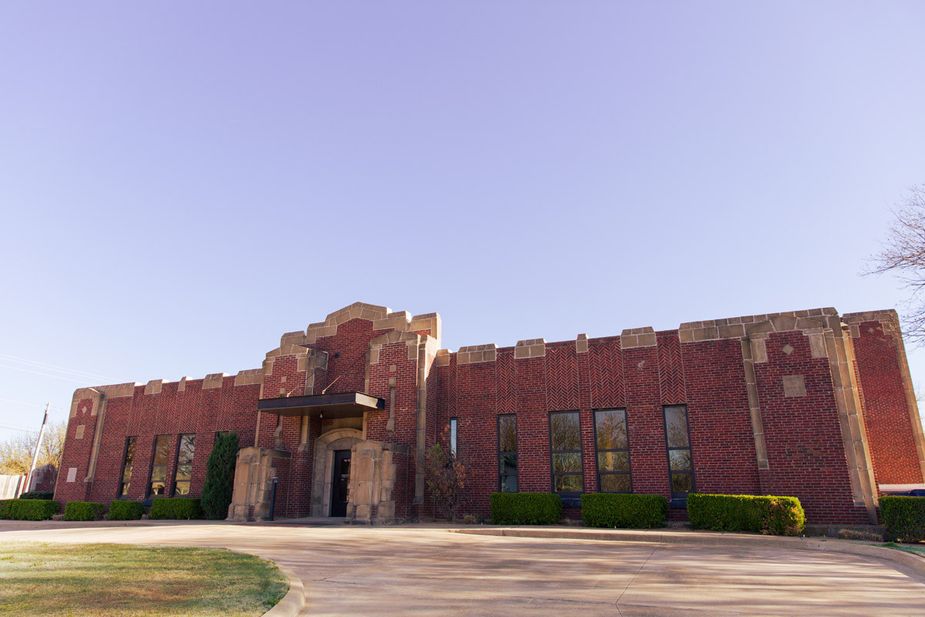
The Art Deco-style Garland Smith Public Library in Marlow is housed in a former armory that is listed on the National Register of Historic Places. Photo courtesy Brent Fuchs
At small-town libraries, staff members know a lot about their regulars—their names, their book preferences, when they need to connect a cold-natured ninety-three-year-old customer with something special.
The last example isn’t hypothetical.
“Our technology director got a heated blanket and took it to her,” says Garland Smith Public Library’s director Tina Bennett, whose voice retains a bit of her native Texas accent. “Less bustle makes it where we have more personalized service.”
In some ways, these libraries—the Garland Smith in Marlow, and Patrick Lynch in Poteau—are opposites. The first, a municipal branch, breathed new life into the old 1936 Marlow armory when it relocated there in 2015, while Patrick Lynch is the newest facility, opened more than a decade ago within the seventeen-branch Southeast Oklahoma Library System (SEOLS).
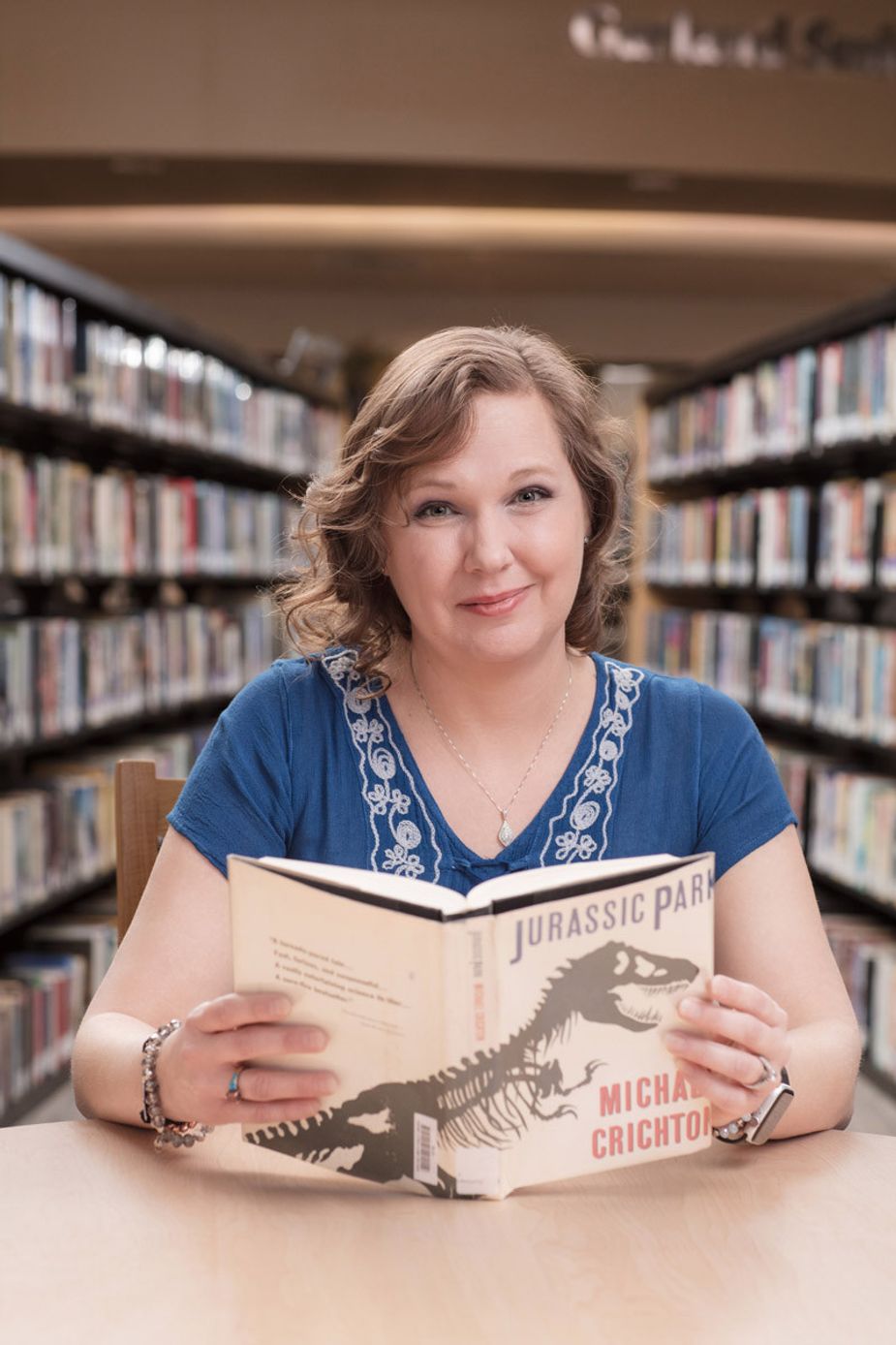
Tina Bennett is the director of the Garland Smith Public Library in Marlow. Like many libraries, it is supported by a local Friends of the Library organization that assists with fundraising and programming. Photo courtest Brent Fuchs
Like most libraries, Patrick Lynch and Garland Smith have children’s areas (Patrick Lynch even has a custom built, hand-painted reading tree with a bench around the trunk for little ones to sit), expansive programming, computer labs, meeting and study rooms, free Wi-Fi, tons of media, and comfy places to hang out. What sets both libraries apart is something richer, an enduring and deeply rooted connection to place and community.
“We do our best to make sure we can offer what our customers are needing, and that includes our services,” says Mona Goodrich, a twenty-two-year veteran of Patrick Lynch and its manager since last December. “If they need something, we will do our best to make sure we can get them that.”
For Patrick Lynch—and all other branches of SEOLS—that includes a “Library of Things” where customers can check out products. If Patrick Lynch doesn’t have the ukulele you need for an upcoming birthday party, they’ll request it from another SEOLS branch. A pasta maker, karaoke machine, movie projector, and Scooby-Doo cake pan (yes, really), are a handful of the other items available. The Poteau Valley Genealogical Society also is located at Patrick Lynch and offers a number of databases and records from LeFlore County and the surrounding area, including Dawes Rolls and census, death, obituary, and cemetery records.
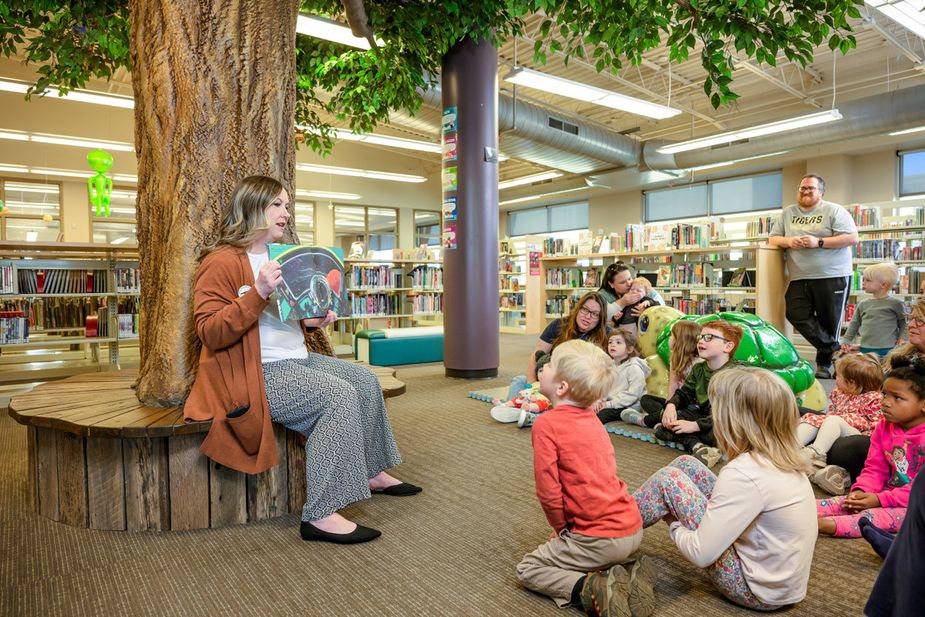
The reading tree in the children’s area of the Patrick Lynch Public Library in Poteau adds an extra sense of awe to literary activities. Photo courtesy Jason Ward
Garland Smith has something even more surprising. Two librarians are convinced the old armory is haunted. Several years back, when Bennett walked the building before opening, she’d hear doors opening and closing and notice lights flickering on and off. Once, the library server crashed, and when a repair technician pulled it out of the IT tower, it was inexplicably full of water.
Bennett never feels scared or uncomfortable, but she also doesn’t walk the building before the doors open anymore. It’s best, she thinks, to leave the late soldier to his business.
“I feel like somebody didn’t get the memo that we’re a library now,” she says. “There’s a guy still reporting for duty every morning, keeping the building safe.”

The Belle Isle Library in Oklahoma City offers a variety of daily programming for visitors that includes children’s events, adult classes, and drop-in sessions. Photo courtesy Charlie Neuenschwander
In the 1960s, architect Jack Mills designed the Belle Isle Library. Ever since, the iconic midcentury modern building on a sloping lot at the corner of Villa and Northwest Expressway in Oklahoma City has been a jewel of the Metropolitan Library System. Nearly half a century later, Steven Matthews of Oklahoma City firm ADG served as principal architect of an $8.5 million expansion that pays respectful homage to Mills’ work while adding more than 10,000 square feet of much-needed space, every inch of which feels like a fit with the building’s bones and soul. In fact, both architects were/are residents of the Belle Isle neighborhood anchored by the library. Some things just make sense.
Belle Isle’s convenient central location always has been a draw for customers, its distinctive circular shape’s aerial resemblance to the Millennium Falcon giving it its Star Wars-inspired nickname. ADG’s renovation walks the line between new and old so skillfully that when inside the space, visitors are struck by a sense of the familiar, while slices of the curved exterior retained inside the space are a reminder of how far these walls have come. The building now is wrapped in a modern glass enclosure interspersed by the original stone and blocks of brick in mid-mod colors orange, teal, and green.
The new Taylor Meeting Room, a large event space on the north side of the building, is the biggest piece of the renovation.
“I would say 95 percent of our programming occurs in this space,” says Risa Jensen-Jones, a regional director for the Metropolitan Library System. “It could be a book club or movie showings, escape rooms, murder mystery-type things—a variety of programming happens in here.”
The Taylor Room is a flexible space with movable floating walls that create multiple rooms. It is home to a vast array of programming, with book groups for kids and adults, arts and crafts, financial planning, cultural celebrations, and a host of child-centered activities, including Wiggly Wednesdays, where fifty preschoolers and caretakers move and groove.
“I call it Wiggly Wednesday, because if I call it storytime, people are afraid to bring their children, because children don’t stand still,” says children’s librarian Tara Golden.
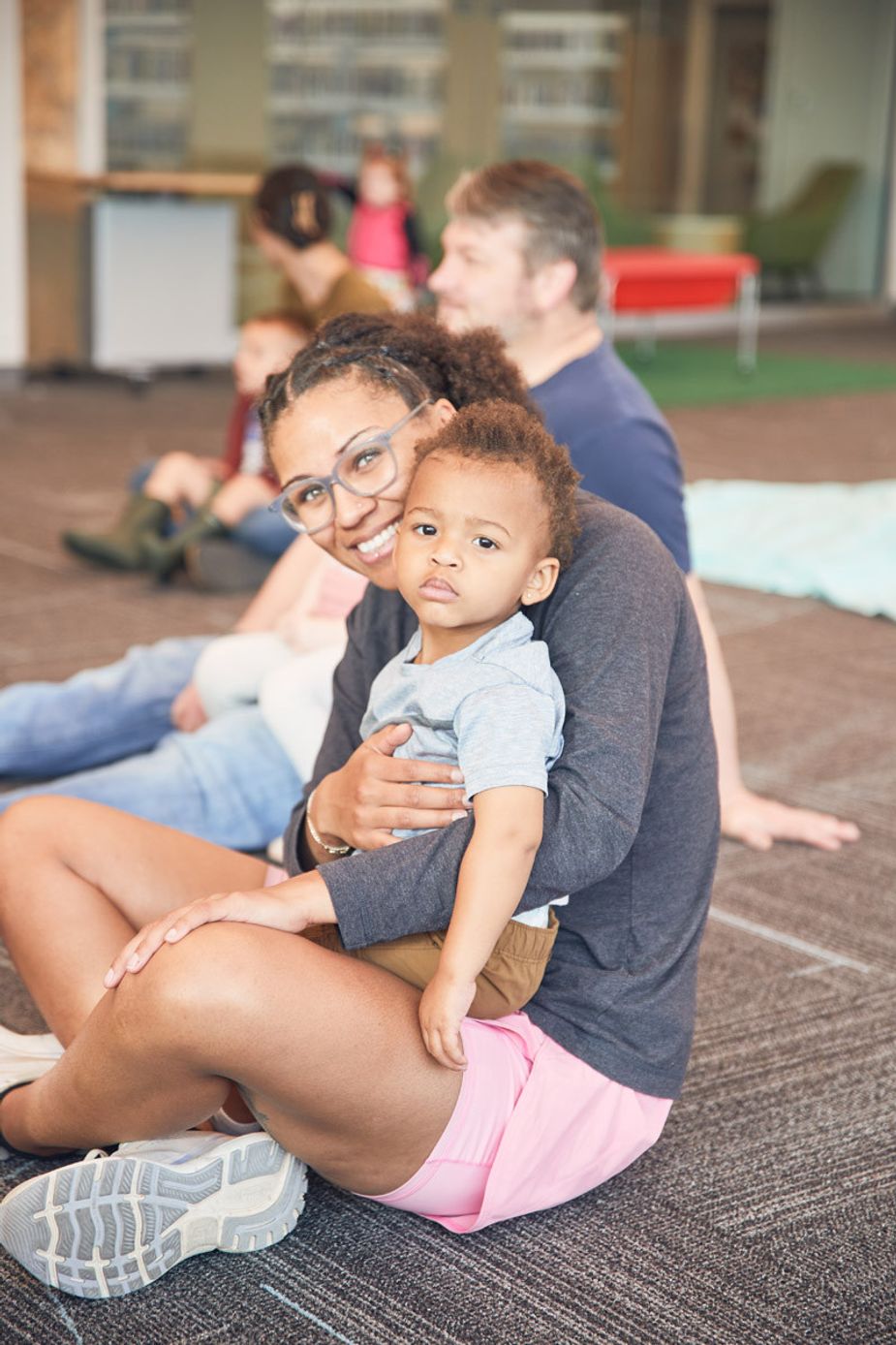
Families enjoy Wiggly Wednesdays at the library, where kids listen to stories, dance, sing, and explore the space. Photo courtesy Charlie Neuenschwander
Also new with the renovation is the library’s popular MLS Studio, AKA Makerspace, with 3D printers, a Cricut machine, sewing and embroidery machines, leatherworking and wood-burning kits, and the only Macs in the building equipped with Adobe Creative Suite.
Belle Isle, unlike many twenty-first-century libraries with active programming schedules and wide-open spaces, maintains an atmosphere of quiet in many of its first-floor public areas. That’s due to integrated state-of-the-art sound containment technology. The five new study rooms have sound baffling to reduce echoing and eliminate ambient noise from room to room. Regardless of how much wiggling, dancing, and singing may be going on in the Taylor Room, customers at a computer just feet away hear almost nothing.
The same holds true in the new children’s library where, with the opening of a door, hushed tones are replaced by the joyful cacophony of children at play. The large space includes modular furniture, play areas, and cabinets with toys and puzzles inside.
“It’s a great space where kids can be kids,” says Jensen-Jones.

The Belle Isle Library in Oklahoma City offers a variety of daily programming for visitors that includes children’s events, adult classes, and drop-in sessions. Photo courtesy Charlie Neuenschwander
Young or not-young, quiet or loud, reading or in motion, isn’t that same childlike spirit of discovery really what makes libraries so integral to their communities? Where else can every single one of us enter through a doorway, feel instantly welcome, and access state-of-the-art technology, almost limitless media, and our own creative power at no or minimal cost?
“Public libraries are the one reliable, safe, welcoming, accessible, knowledgeable space that’s embedded in the community that people can turn to,” says ODL director Natalie Currie. “We have such an amazing, healthy library ecosystem in our state. We’re so fortunate.”







